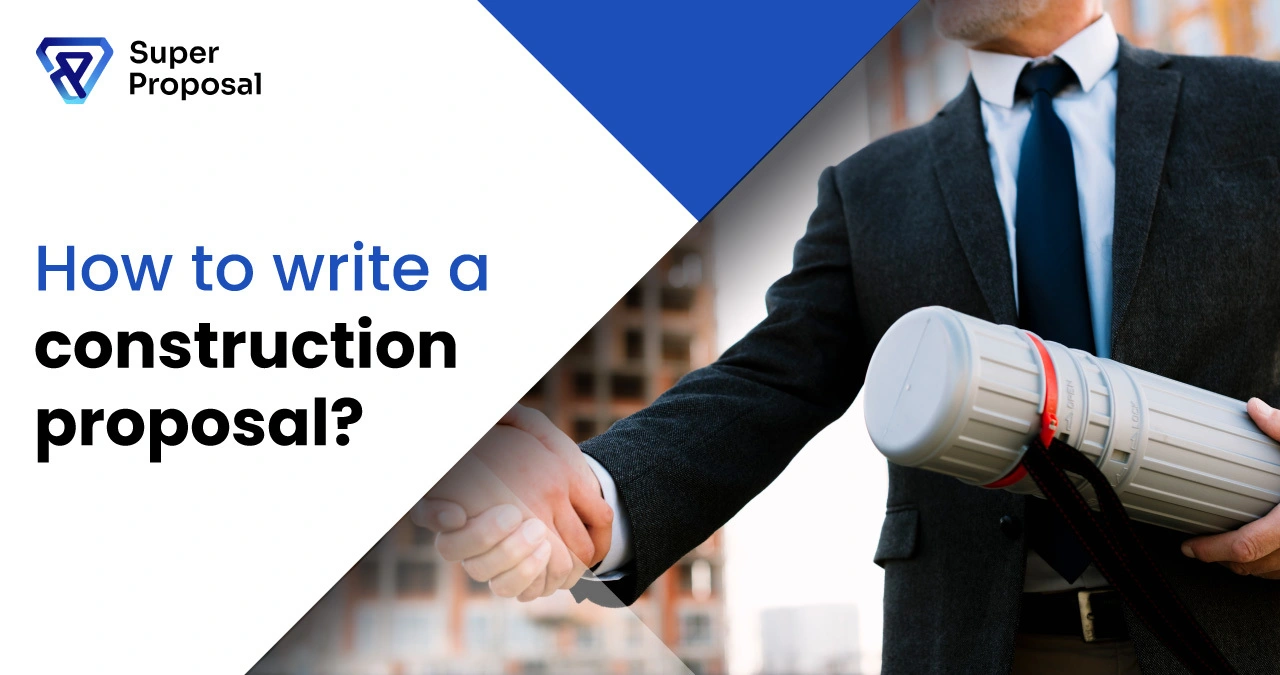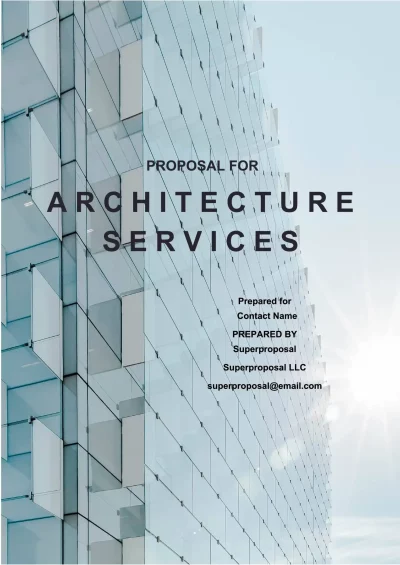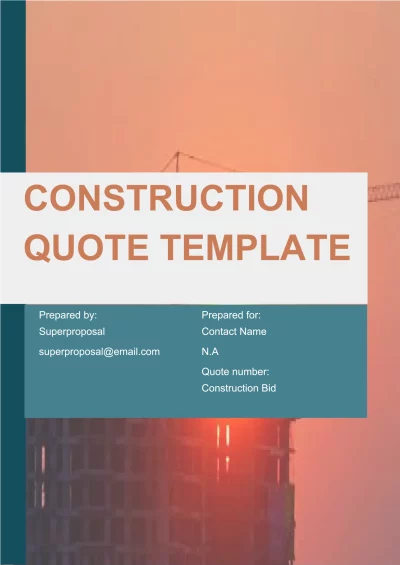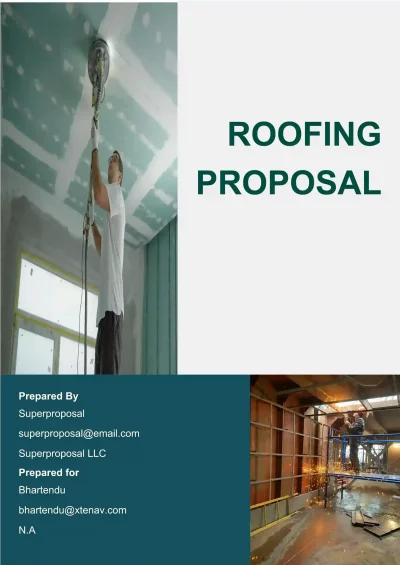How To Write a Construction Proposal in 2025: Free Templates & Tips
AUG 23, 2024 | LAST UPDATED ON OCT 2, 2024 BY ANGELICA NAIDU

“The door handle is the handshake of the building.” — Juhani Pallasmaa.
Like a firm handshake at the outset of any meeting, a well-drafted construction proposal is also crucial in your sales process.
In this blog, let’s understand the essential elements of a winning construction proposal. By the end, you will have the knowledge and tools to create proposals that open doors to new opportunities. Let’s get started!
Table of Contents
ToggleWhat Is a Construction Proposal?
A construction proposal is a formal document that a construction company or contractor submits to a potential client. It outlines the project overview, scope of work, cost estimates, timelines, and terms and regulations.
An ideal construction proposal should be detailed and personalized for the client.
What Does a Construction Proposal Include?
A typical construction proposal includes the following key elements:
- Project Overview: Introduce the project and its aims and purposes.
- Scope of Work: The comprehensive description of all the steps to be taken within the framework of the work.
- Cost Estimates: They are a breakdown of all probable expenses that should be incurred in the project, such as material, wages, licenses, and other charges.
- Timeline: A proposed table that splits each project phase by the project start date and anticipated date of project completion.
- Terms and Conditions: These are legal conditions of the project, which may include payment conditions on the project, method of solving disputes, and warranties.
Why Construction Proposals Are Important
A construction proposal is a significant business tool for your business and legal relationship with the client. Let us consider the reasons as to why construction proposals are essential:
Brand Identity:
It is vital to understand that your proposal primarily represents your company brand. It is a chance to introduce your company, give you and your team a view of what is valuable, and look professional.
Tip: Invest in good design and branding on the image to distinguish your proposal. A clean and presentable proposal that the client can read and review can be advantageous.
Use Super Proposal to design professionally crafted proposals that match your company’s branding and complement your previous work.
Clarity and Understanding:
A construction proposal outlines the tasks, timescale, and amount of money required to characterize an efficient proposal. It guarantees that the buyer and the seller have similar expectations of what will be supplied and the price to be paid.
Transparency and Trust:
Client satisfaction is critical in organizations, and transparency must be part and parcel of how clients are treated. A construction proposal must clearly outline the services on offer, the product used, and their cost. It should also outline possible problems that will likely arise during the undertaking.
Project Resource Planning:
Construction proposals can also be viewed as the basis for construction planning. They assist in resource management by directing resources to the right places at the right time and helping to schedule and coordinate activities.
Project management tools and similar software help track progress and tasks and help avoid exceeding the project budget.
Client Decision Making:
A construction proposal also serves as an important resource for clients to assess the bids made by different contractors. A professional construction proposal can influence the client’s decision in favor of your company by displaying your company’s USPs that set you apart from your competitors.
What Is Included in a Construction Proposal?
A comprehensive construction proposal is your key to winning contracts and setting clear expectations with your clients. Let’s break down the essential components you need to include:
Contact Information
This section outlines the full contact information for both the contractor and the owner, including:
- Full Legal Names: Ensure accuracy for legal purposes.
- Business Addresses: Physical locations for official correspondence.
- Phone Numbers: Provide direct lines for easy communication.
- Email Addresses: For quick and efficient contact.
- Additional Contacts: If applicable, include project managers or other relevant personnel.
Example:
Contractor: ABC Construction Inc.
123 Main Street, Anytown, CA 12345
Phone: (555) 555-1212
Email: [email address]
Specification of Parties
This section identifies clearly, and without doubt, the parties involved in the contract for purposes of clarity and validity. It includes:
- Full Legal Names: As they appear on official documents, to avoid doubts.
- Federal I.D. Number (if any): This is important for businesses to help with identification and even for tax purposes.
- Addresses: Current physical addresses for both parties.
- Contractor’s Registration Number: It would be important to prove that the contractor is legally valid.
- Salesperson(s) Involved (if any): This information can be sent to the parties involved during commission or for contact purposes only.
- Date of Execution: The date on which both parties signed the agreement.
Subcontract involvement
It is essential to specify the tasks to be assigned to the subcontractor, the performance criteria to evaluate their performance, the associated costs for their fees, and the liability for their work.
Exclusions
Mentioning what is excluded from this agreement is equally important and practical. This will prevent misunderstandings in the future.
For example, when renovating a kitchen, your work could include knocking down walls, fitting cabinets, putting up new countertops, laying floor tiles, and painting walls. Exclusions could be fixing appliances such as washing machines, installing ovens, or electrical work.
Scope of Work
Every step from the initiation of work to when the same is completed outright is fully documented, including any material to be used, how these are to be used, and what steps to follow.
Work Schedule
This elaborates the expected schedule for the finalization of said project, recognizing the possible variables that may impact the scheduling.
Start date: The project is scheduled from [Start Date].
Substantial completion date: The project is expected to be substantially completed by [Substantial date].
Permit acquisition: [estimated time frame] is allocated to obtain the necessary permits.
Weather contingency: The schedule accounts for potential delays due to adverse weather conditions, with [number] days of buffer time.
Other delays: Additional time has been factored in for unforeseen circumstances, such as material shortages or unexpected site conditions.
Example:
Start date: August 1, 2024
End date/Substantial completion date: December 30, 2024
Permit Acquisition: 2 weeks
Weather Contingency: 5 days
Other delays: 1 week
Relevant Authorities
This identifies the authorities and Acts to which this project is accountable and ensures that the demands of every applicable law, code, and industry are complied with. Including:
- Building permits: Must meet all municipal building codes and zoning ordinances.
- Environmental regulations: Must meet all laws and requirements pertaining to environmental protection.
- Safety standards: Must meet a minimum of OSHA requirements and best management practices within the industry.
- HOA Rules (if applicable): Comply with any restrictions or guidelines the HOA sets. Other relevant authorities: Any other regulatory agencies or permits required for the specific type of work being performed.
Cost Breakout:
Provide a detailed breakdown of all project costs. Start with the total cost on the first page of your proposal for easy reference. If the breakdown is extensive, you can include it on the following pages.
Example:
- Direct Costs: Materials, labor, equipment rentals, subcontractor fees.
- Indirect Costs: Permits, insurance, project management fees, overhead expenses.
- Payment schedule: Make sure to note when all the payments should be made. Note down a schedule for the same, for instance:
- 20% deposit: At the time of signing the contract.
- 30% payment: Completion of framing and rough-in.
- 30% payment: Completion of drywall, flooring, cabinetry, installations.
- Final 20% payment: Final completion, inspection, and approval of all work,
Terms and Conditions:
This area provides the legal scaffold for the whole project process. This section enables one to protect the rights and obligations of both parties. The following will be included regarding
- Liability: The responsibility of every party in case of damage, accident, or loss.
- Insurance: Specifies the types and extent of insurance that each party is to carry.
- Warranty: Warranty from the contractor concerning materials supplied or workmanship.
- Dispute resolution: Outlines the management processes and procedures to address disputes.
- Termination: Indicates circumstances under which a party may terminate the contract.
- Force Majeure: This means any events that may prevent or delay the completion of work. Any such event shall discharge both parties of all kinds of liabilities.
- Governing Law: States the state and the laws by which the contract is to be governed.
- Other Provisions: Other provisions may include confidentiality, intellectual property rights clauses, or other particular industry regulations.
Warranty:
A warranty demonstrates your commitment to quality and customer satisfaction.
This section includes workmanship, materials, and other additional warranties regarding particular items.
Signature line:
Make certain to leave space for your signature and your client’s. This further cements the agreement and makes the start of your project legally official.
Read more: How to write a contract proposal
Example of construction proposal template (PDF)




Read more: 14+ Project Proposal Examples and Templates
7 Tips For Writing Your Construction Bid Template
When writing a construction bid proposal, it’s essential to follow these key tips to create a compelling and professional document that sets you apart from the competition:
- Customize Your Proposal: The proposal should address a specific project or client. Avoid template types that are so general that they can be used with every product or service. Tailor and adjust the language and formatting to show that the proposal respects the client’s needs and expectations.
- Use Professional Design: The design of your proposal should be clear, professional, and visually appealing. Ensure all bullet points have the same format, that images are high quality and resolution, and that all the section headings are well written. The document should be easy to read and navigate so that readers can easily find what they are looking for.
- Be Specific: Specify what you and your contractor will do, what they will use to complete the task, and when it will be finished. Avoid saying things like ‘we will try our best’ or making promises that may prove impossible on your part. And stand for what is practically achievable.
- Demonstrate what your client wants: Show the client that you can identify with their issues and that, with your services, you can solve or help to solve them. Emphasize your previous work experience in similar implementations and knowledge of the industry. Talk about your strategy and how it can benefit the client regarding cost, time, or quality of the work delivered.
- Checklists: You could develop a checklist covering all key areas that must be culled for a good construction bid proposal. You will have to tick off these items as you prepare the construction bid proposal. On this list, ensure that the client and contractor information, the project description, existing conditions, cost estimate, and payment provisions have been covered. This will aid in the preparation of an easily readable and coordinated proposal.
- Plan Out a Proper Timeline: While formulating the project schedule, a detailed timeline shall be drawn up concerning other necessary steps and time limits. Make sure your schedule is as firm as it needs to be. Describe how you would manage the communication with the client and solve any problem or delay that could happen during the project.
- Ascertain that the data is right: Test the contact data, the project’s description, the cost, and the referencing utilized in the proposal. Wrong information will bring minus feasibility to a proposed idea, and that may cause clarity that may result later.
Construction proposal mistakes to avoid
When crafting construction proposals, seemingly minor errors can snowball into misunderstandings, disputes, or even the loss of a contract. To ensure your proposals are successful, it’s crucial to steer clear of these common pitfalls:
- Unclear wording: Using simple, explicit language is better for being clear and concise in each part of the proposal. Avoid excessive technicality in the use of words unless necessary. Still, if this has to be done, terminology should create a clear meaning and be defined to provide a common understanding between the parties.
- Unclear Payment Terms: One of the biggest mistakes is not clearly defining the payment terms. Your proposal must mention the total cost of the project, the payment milestones, and a process for handling additional costs or new scope items. If these are not provided for, disputes can arise over payment, bringing financial insecurity and spoiling your relationship with your clients.
- Using Non-Customizable Templates: Most contractors rely on fixed proposal templates for construction, which makes it challenging to tailor an offer to meet specific client and project needs. Super proposal can help by making all your templates specific to a construction project’s peculiarities.
Business Proposal Executive Summary Examples
FAQs
Do I need a proposal and a contract?
Yes, both are required. A proposal outlines the scope, timeline, and cost of a project, whereby a contract legalizes the accord for the two parties.
What’s the difference between a proposal and an estimate?
A proposal is a document that clearly describes what a client can expect from the project regarding deliverables, timeline, and terms of payment. The estimate is a rough calculation of the presumed cost of undertaking a particular project.
Can a construction proposal be customized?
Absolutely! Every construction project is unique. Customizing your proposal enables it to cater to the specific needs and requirements of each client.
Is a construction proposal legally binding?
Generally, no. However, if accepted, certain elements within the proposal may become binding upon entering into a contract.
How Do I Write an Independent Contractor Proposal?
Generally speaking, no, but certain components of the proposal may be legally binding once action is taken to form a contract.
How Do I Respond to a Construction Request for Proposal (RFP)?
Highlight your qualifications, experience in the related sector, and a detailed outline of a plan to undertake the project. Clearly define the scope of work, terms of payment, and details of the timeline.
What is the difference between a Construction Bid and a Construction Proposal?
It is important to understand that although the terms construction bid and construction proposal are used as synonyms, there is a slight difference between them.
- A construction bid focuses on the cost factor and its bearing on the project.
- A detailed construction proposal should include the estimate and other descriptive history related to the proposed project, including scope, time frame, plan, and other essential details.
Increase your close rates today!
Secure every pitch that you make with Super Proposal. Craft winning proposals, share and track them on a single, comprehensive platform.
✓ 15-Day Trial. No Credit Card Required.

Recent Post



